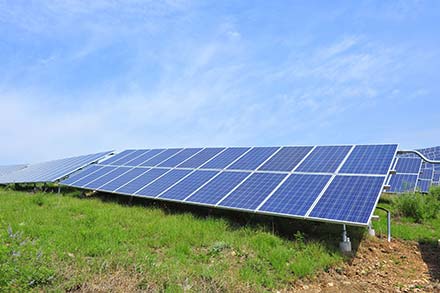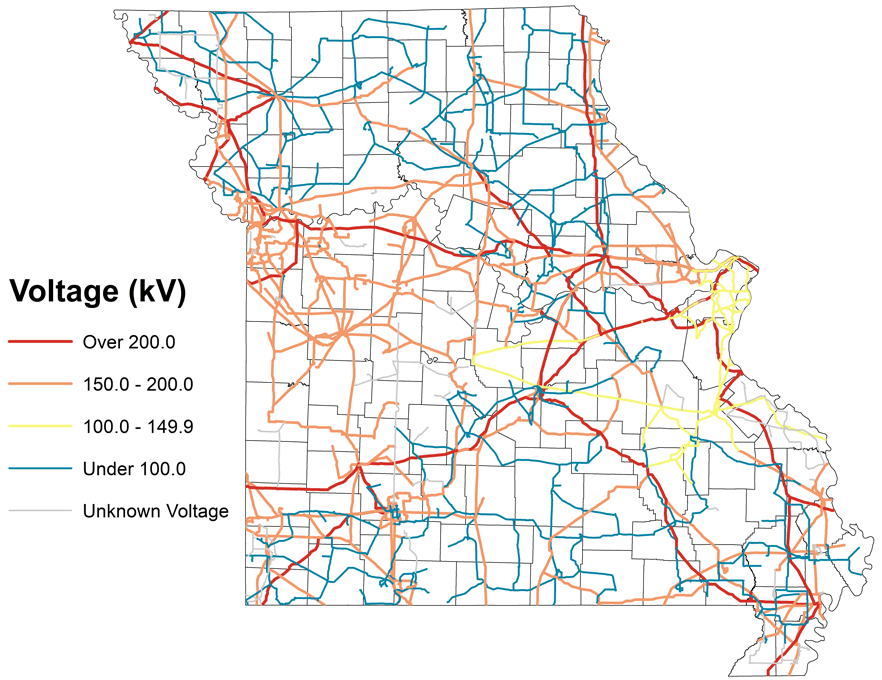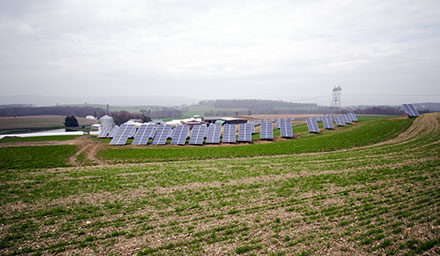Leasing land to develop utility-scale solar energy farms is becoming more common in Missouri. Renewable energy developers are proposing leases to Missouri farmland owners near select transmission lines and substations.
Utility-scale solar energy projects bring opportunities and threats for Missouri farmers and landowners. This publication uses information developed by land grant universities, in states where solar energy development is more common, to inform landowners that are considering utility-scale solar energy development land leases.
This publication does not constitute professional or legal advice. Lease terms and conditions have long-term implications because solar energy leases last for decades.
Advice of an attorney experienced in reviewing solar energy leases is helpful in understanding lease terms and conditions. Accountants and farm advisors can also help you understand how solar energy lease proposals affect your land, farm and family.
Introduction to solar energy leasing

Solar energy land leasing opportunities arise from the development of utility-scale photovoltaic (PV) solar energy systems typically designed to generate more than five megawatts (MW) of electricity. Projects typically cover at least 25 acres.
A utility-scale PV solar energy system connects to a substation that raises the voltage and sends electricity directly to the transmission grid. Utility-scale solar energy systems are increasingly being planned with battery storage to store electricity.
The estimated nameplate capacity at Missouri’s utility scale PV solar energy installations was 101 MW in March 2024 and planned growth of 386 MW in the next few years, according to the U.S. Energy Information Administration.
Who are the players?
Regulated utilities and municipal utilities generate and distribute a large majority of Missouri’s electricity to the state’s electricity customers. Electric cooperatives also distribute electricity locally to a large geographic footprint in rural Missouri.
Landowners may be familiar with utilities offering solar energy leases. But it is also common to receive proposals from lesser-known renewable energy development companies that plan to sell power under contract to a utility, industrial customer or out-of-state buyer.
Site suitability
Developers of utility-scale solar energy farms seek land next to existing uncongested transmission lines and substations. Attractive sites may be remote from urban areas. This is illustrated by the extent of red (higher-voltage) transmission lines in Figure 2.

Solar energy leases can also be possible on marginal or deteriorated lands, including brownfield sites. There are some barriers for project development on marginal farmland. These include land slopes that are steeper than solar energy development specifications. Other barriers include nearby overhead barriers and forested and brush-covered lands that must be cleared before solar energy installation.
Economic considerations
There are economic issues for landowners to consider in solar energy lease proposals.
Land availability
Land is a fundamental resource for farming, and the amount of land is limited. Utility-scale solar energy land leases are often written for 25 years or more with options to renew. This creates a long-term land use constraint that could impact multiple generations of landowners.
Landowners should think carefully about how solar energy leases might complement or conflict with their goals. A solar energy lease could conflict with farming goals if the proposed site is an integral part of how the farm will achieve its long-term business plan and goals.
Land impacts
Most land impacts from utility-scale solar energy projects will occur during construction. The site access may require road construction and land grading. Concrete trucks, semi-trailers carrying supplies and equipment will enter and exit during solar array construction. Construction and equipment may cause subsurface compaction and potentially impact surface and subsurface drainage. Although long-term impacts may be hard to estimate, you can compare probable compaction from construction with known compaction from farming activities at the proposed site.
Soil testing could be conducted prior to construction to establish a baseline for pH, nutrients, soil texture, organic matter and heavy metals. This could be repeated periodically throughout the lease to monitor any change in soil conditions.
There is little if any land disturbance after construction. The operational solar energy project has virtually no moving parts and sits on the land behind a fence. There are no known noises, smells or emissions from the solar array. Energy company employees may enter the site for maintenance periodically.
Mowing or spraying may be used to control vegetation at solar sites. If you know the site has a certain noxious weed or invasive species history, you might negotiate lease terms for vegetation control that would prevent any weed recurrence or spread.
The solar energy lease should specify how the solar equipment will be removed at the end of the lease. Most importantly, the lease should include the solar energy developer’s responsibility for equipment removal and land renovation. The lease should also specify how equipment removal and land renovation are legally assured if the solar energy company fails to perform or ceases business. This could be accomplished with a removal bond requirement in the lease.
Farm financial planning
A utility-scale solar energy lease could have both positive and negative impacts on farm profitability. On one hand, returns per acre from a utility-scale solar energy lease — even after property taxes and other land ownership costs — can far exceed farm enterprise returns or farmland cash rents. This could create greater cash flow from that piece of land. On the other hand, removing land from farm production for a solar energy lease can require finding other land for grazing, cropping and other farm production.
Solar energy leases may also have short-term impacts upon farm profitability. There is usually a time range given for when construction of the solar array will begin. The exact start date could impact crop or livestock enterprises on the land. Solar energy leases will often include compensation terms for farm products impacted by the start of PV solar construction. You can review the lease terms to see how you would be compensated for any actual or potential income loss.
A solar energy lease may have positive or negative impacts on your farm’s borrowing capacity and relationship with farm lenders. Lenders may view increased cash flows from solar energy leases as potentially improving debt repayment capacity. Conversely, lenders may be unwilling to accept land leased for solar energy development as loan collateral.
Legal considerations
Title and ownership
You must have a good (or “clean”) land title in order to negotiate a land lease. Other parties with ownership, easements, or other rights to the land, could be a deterrent for the solar energy developer.
Farmland joint ownership is common. Joint owners may include multiple heirs of different ages with different perspectives on how the land should be used. Because each legal owner must consent to the solar energy lease, joint ownership could complicate negotiations with the energy developer.
Common lease documents
Energy developers typically request landowners to sign multiple documents during the land lease process. These are the three most common documents:
- Letter of intent
- Option to lease
- The solar lease or purchase agreement
A letter of intent (sometimes called a term sheet) reserves the land for a particular energy developer. This limits the landowner’s right to negotiate with other developers. The letter of intent can vary in detail from a very brief letter to a more detailed description of the eventual intended lease. The letter of intent may or may not be a legally binding agreement.
The option to lease is a legally binding agreement in which the landowner grants the developer the right to lease the land. The lease may not occur right away; the time period is specified within the option. There may be limits on land use during that interim time.
The solar lease is the longer-term agreement between the landowner and the energy developer. The lease may include payment terms on an annual per acre rate, liability and tax responsibilities, renewal terms, removal bond and other sections.
The option to lease is sometimes included within the lease itself. Each document should be signed only when all terms and conditions are fully understood.
Solar energy leases can be negotiated — just like land leases for crops and livestock. It is in the landowner’s best interest to fully understand the lease terms offered. The landowner may then seek to negotiate those terms.

Property taxes and land use
Property tax assessment information on solar energy systems can be sought by contacting the Missouri State Tax Commission or your local county assessor. Situations vary, but it is important to connect with officials to understand the taxation impact of solar energy systems and who (developer, landowner) is responsible for paying it.
Changing land uses may impact tax rates. Changes in tax rates are related to state and local land use laws and zoning. Attorneys and accountants familiar with state and local land use and tax laws can help landowners understand possible impacts of solar energy leases upon property tax rates and allowable land use.
Government programs
Solar energy development could potentially impact land conservation program contracts. Discussions with local or regional USDA personnel can provide landowners with additional information and insights about these potential impacts.
Liability risk
Liability insurance requirements for landowners and lessees vary based on contract language and situation. These are some common liability concerns for landowners considering solar energy leases:
- Who is responsible for damages or injuries during solar array construction?
- Is the landowner liable for injuries to solar energy company employees maintaining the equipment?
- Who is liable if damage to the solar equipment occurs from other property users (hunters, custom equipment operators, loggers, agency personnel, farm employees, etc.)?
- How could indemnification clauses in the lease expose the landowner to future liability?
Landowners may consult with attorneys, insurance professionals and other experts to measure potential liability risks from a solar energy lease.
Impacts on landowner rights and land use
A solar energy lease will limit what the landowner can do on and around the leased land. Landowners should thoroughly review the lease to understand any present and future land restrictions.
Solar energy leases also commonly include “noninterference” provisions that state a landowner must not interfere with the construction and operation of the solar equipment. This usually includes overhead interference like nearby trees and other things that may cast shadows on solar panels.
It may be possible to seek an agrivoltaics agreement from the developer where you are allowed to graze livestock around solar arrays.
The lease will likely require the landowner to obtain permissions from the solar energy developer to access or use the leased land. Landowners should ensure they have access to farm land the developer decides not to lease because that land could be blocked by leases of other tracts. Careful attention to maps, legal descriptions and setback distances included in the option to lease will prevent land from become unusable behind exclusion fences.
Landowners will benefit by maintaining appropriate communication and obtaining the permissions required in the lease. However, landowners need to understand that the lease may be transferred to different solar energy farm owners during the life of the lease. To avoid disputes, get agreements in writing.
Land easements may be needed for construction and operation of the solar array.
Social considerations
Impact on family
Consider the solar energy lease implications upon family business and succession plans. Different generations of the family may have different goals. Retirement and farm expansion are areas where disagreement may arise.
Family members may also have diverse perspectives on farmland use for solar energy development. Families should discuss potential leases in ways that provide healthy conflict resolution and allow respectful voicing of different points of view.
Impact on community and neighbors

New land uses, including the advent of new businesses and industries, often stir up “not-in-my-backyard” (NIMBY) sentiments. Objections could include changes in the appearance of the local agricultural landscape and conservation concerns. Each situation varies by community and locality. Local zoning has emerged as a way some communities have combated large-scale solar energy development. Landowners need to use their knowledge of the local community and neighbor relationships to gauge potential community impacts from a solar energy project.
Solar energy developers and solar industry proponents respond to these concerns by pointing out ways that utility-scale solar energy may be integrated into the rural community. Some utility-scale projects that combine agriculture and solar energy, such as sheep grazing on solar development or pollinator habitats planted alongside PV solar, may lead to broader community acceptance of the project.
Conclusion
Missouri farmland owners near transmission lines with desirable interconnections may see increased solar energy lease opportunities. These long-term leases require careful evaluation by farm owners and operators, including the possible impacts of PV solar upon the farmland, farm business and family goals. Finally, farmland owners should be attentive to community and family impacts from negotiating and executing a solar energy land lease.
Resources
- Farmland Owner’s Guide to Solar Leasing (PDF). National Agricultural Law Center. June 2020.
- Legal Issues Surrounding Due Diligence for Solar Development. NC State University Extension. Feb. 2022.
- Solar Leasing: A Guidebook for Agricultural Landowners. American Farmland Trust. November 2022.
- University of Missouri Soil and Plant Testing Laboratory
- Utility Scale Solar Development. Ohio State University Extension.